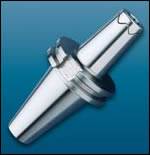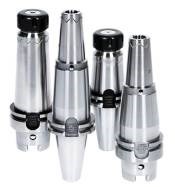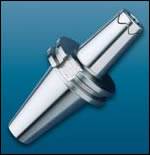Increase Productivity with Balanced Toolholder Assemblies
During these times of economic uncertainty, it’s more important than ever for manufacturers to make sure they are getting the most efficient and productive use of their equipment. Operators of machine tools can do this by finely balancing the tools and toolholders being installed on their machines.
There is an overriding misconception in the manufacturing universe that only manufacturers who perform high-speed cutting benefit from balancing their tools before putting them to work. The fact is anyone who cuts anything on a machine tool stands to benefit from the improved productivity and process reliability, and increased tool and spindle life that result from balancing.
The key for maximizing possible machine tool productivity is to have a truly balanced tool holder assembly (this assembly means toolholder, cutting tool, collet, pull-stud, etc.—all married together as an assembly exactly as it will be run in a machine tool spindle).
An unbalanced tool assembly, caused by uneven weight distribution, results in the following: vibrations that have adverse effects on the part being produced, the machine to be run at a less-than-optimum speed, decrease the life of the tool itself and is detrimental to the spindle. While it’s true that the negative effects of an unbalanced tool are more noticeable in higher-speed applications, they also can be seen with heavy tools and on those cutting tools with complex geometries. These negative effects may be more subtle at slower speeds, but are no less critical.
The centrifugal force caused by an unbalanced tool puts a strain on the spindle bearings, which reduces the spindle life by approximately 50 percent. The vibrations are transferred throughout the entire machine, and in particular the cutting tool, which can significantly shorten the cutting tool life. The tool life for an unbalanced toolholder assembly (toolholder with cutting tools, nuts, collets, screws, inserts, etc.) is shortened by 10 percent on average. The result is an increase in a shop’s day-to-day cutting tool costs.
Process Reliability and Higher Productivity
These vibrations are not only harmful to the spindle and the cutting tool, they impair process reliability and are transferred to the machining results. They create chatter marks that have to be removed by additional fine machining or handwork. Due to the labor costs associated with benching work on molds, and the increase in global competition, it is crucial to minimize this handwork time. To reach the correct levels of process reliability and the final results demanded, the vibrations have to be reduced during the machining process. One way of doing this requires reduction of spindle speed, feedrate and cutting depth. This leads to smoother cutting, but also to a lower metal removal rate and therefore decreased productivity.
Assume that a machining center costs approximately $126 per hour to run (one-shift operation, 1,600 operating hours per year). With an increase of metal removal time of just 10 percent you save close to $13 per hour. That adds up to more than $20,000 per year—which is a lot of money.
Adding to the productivity is the fact that when spindles last longer, their replacement can be planned, preventing costly unplanned machine downtime. So, ultimately, a manufacturer can save more than $25,000 per year, per machine with a truly balanced system—not including savings that can be made by improved surface quality, higher accuracy of size and fewer machine breakdowns or downtimes.
Testimonials
J.L. French Automotive Castings Inc. (Sheboygan, WI) uses shrink-fit toolholders and tool balancing equipment when it machines at both low and high speeds approximately 80 percent of the components it die casts. The result is faster throughput, more accuracy, greater flexibility and superior finished parts, according to Warren Hacker, J.L. French’s manager of North American MRO Purchasing.
One of the ways the toolholders and balancing helps is with long extensions, sometimes as long as 12 to 14 inches, that J.L. French uses to machine complex castings. “By heat shrinking and balancing these extensions, I’m able to obtain penetration rates that are the same as standard-length tooling,” Hacker explains.
At York Technical College (Rock Hill, SC), Tom Dickerson, the school’s Machine Tool Technology Department Manager, uses shrink-fit and balanced tools on the many machine tools it uses in its instruction. “We want to try to get ahead of local industry to try to show them the way to do things a little bit better,” Dickerson says.
Balancing Is Simple and Quick
Even knowing what we now know, there are still reservations on the subject of balancing. With the correct balancing machine and practice-oriented software, balancing is quick and easy to do. The operator puts the holder in the machine and selects the suitable requirements in the menu. From then on the machine tells him what to do.
The balancing process is largely automated. During a measurement the holder is clamped in the balancing spindle and set in rotation. The unbalances cause centrifugal forces that are measured on the balancing spindle by force sensors. The software then deals with the evaluation of the measurements. It shows the operator on the screen where and how much material should be removed or added, or where to displace weight in order to compensate for the unbalance.
There also are various options available that he can turn to for removing unbalances. As an alternative to drilling off material, the balancing rings can be used. Two rings that belong together and have a defined unbalance are clamped on a cylindrical portion of the toolholder in order to compensate for unbalances in the toolholder assembly. In this case the software provides the exact angular degree to which the rings should be turned. A line laser that shows the position for rotation directly on the machine is also extremely practical.
Complete Balancing
The complete balancing process can be done quickly. Measuring takes at the most one minute and if you work with balancing rings the complete process can be completed in two minutes. If you have to resort to a drill on the toolholder to even out the mass, it takes slightly longer.
The current economy carries many variables that are not in a manufacturer’s control. One element that can be controlled is the operation of their own in-house, existing equipment. Operating balanced tools on equipment can make it as accurate, efficient and productive as possible.
Related Content
Revisiting Some Hot Runner Fundamentals
What exactly does a hot runner do? If you’ve been in the injection molding industry for any length of time, you might think the answer is obvious, but it is not.
Read MoreHow to Eliminate Chatter
Here are techniques commonly used to combat chatter and guidelines to establish a foundation for optimizing the moldmaking process.
Read MoreMachining Center Spindles: What You Need to Know
Why and how to research spindle technology before purchasing a machining center.
Read MoreLaser Welding Versus Micro Welding
The latest battle in finely detailed restoration/repair of mold materials.
Read MoreRead Next
Shrink Fit: The High Accuracy Toolholder of Choice
Requirements in the mold industry are much more precise than general machining, so more attention must be paid toward the selection of the appropriate toolholder in regards to its features and benefits.
Read MoreAre You a Moldmaker Considering 3D Printing? Consider the 3D Printing Workshop at NPE2024
Presentations will cover 3D printing for mold tooling, material innovation, product development, bridge production and full-scale, high-volume additive manufacturing.
Read MoreHow to Use Continuing Education to Remain Competitive in Moldmaking
Continued training helps moldmakers make tooling decisions and properly use the latest cutting tool to efficiently machine high-quality molds.
Read More













.png;maxWidth=300;quality=90)










